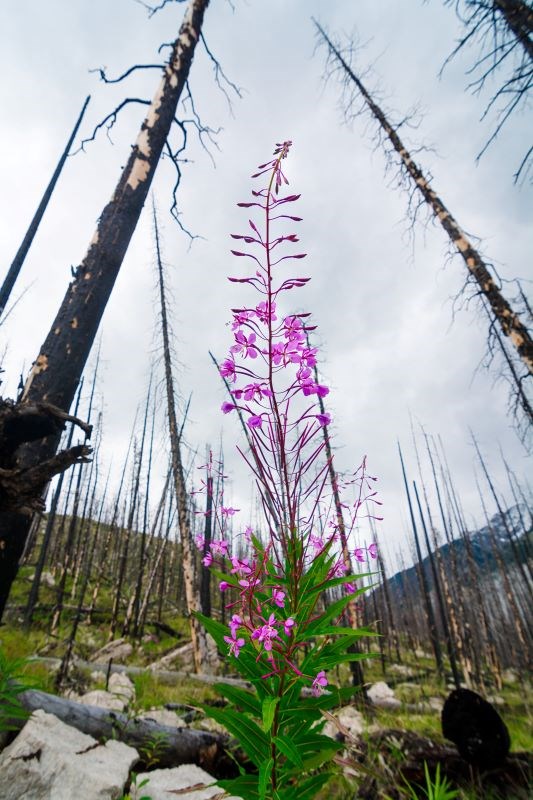
Scott Hayes, Local Journalism Initiative Reporter | [email protected]
Here’s a hot topic: how do you like to spend your summertime in the age of climate change?
This is generally viewed as the season of campfires and fireworks, but those can have precipitous consequences. For many right now, fire is to be feared.
has another perspective to offer: one of fire’s importance to ecology and the natural life cycles of the world. She put her camera toward prior wildfire sites in Boreal forests around Alberta, capturing some of the new life that only occurs after the land has been burned.
Her travelling exhibit called “Carbon” is meant to spark some conversation if not catch some eyes with her striking nature photography of 15 large format images. After all, fireweed doesn’t just make for pretty pictures, especially when those pinkish wildflowers are surrounded by charred trees.
The Grande Prairie-raised arts and humanities grad admitted that she is not a professional photographer, but she already had a strong understanding of the role that photography plays in the public’s conceptions of wildfires.
She commented on how photography of wildfires typically focuses on the apocalyptic: vast flames consuming trees and homes; people and animals fleeing in terror; the smoked-out skies with the wasted lands beneath.
During the pandemic, she returned home to northern Alberta to reacquaint herself with the Boreal forests via an extended bike tour. Inevitably, she encountered burn sites including the Excelsior burn around Medicine Lake.
“I thought to myself that it would be a really great opportunity to pair photos alongside written words, to try to create a better understanding of what the perception of wildfires currently is and what it could be,” she said.
There isn’t one burning message that she hoped to convey with “Carbon,” only striving to broaden people’s perspectives on wildfires. The exhibit does offer one pause to reflect on the fact that wildfire is a necessary link in a forest’s lifecycle. Observe the lodgepole pine needing fire to release its seeds.
She referenced environmental historian Stephen Pyne who observed that fire’s relationship to humanity is complicated to say the least. The element carbon offers a pivotal viewpoint, which is reflected in the title of this show. After all, carbon is the primary organic unit of all biological creatures yet is also one of the obvious remainders after a fire.
In her artist’s statement, Magusin offers her view that Alberta’s natural ecosystems and its oil and gas industry aren’t irreconcilable, only “different expressions of a similar millennia-old process: creative destruction through fire.”
While she began the project to reconcile our concurrent reliance on and fear of fire, her photographs stand on their own merits with glimpses of wonder emerging phoenix-like from the blackened and destroyed landscape.
“It’s challenging because these photos are divorced from their context and divorced from the ecological understanding that I have that led to their genesis.”
She expressed hopes that people would use the accompanying educational package to further their understanding and appreciation of her work and the important ecological role that wildfires play in the Boreal forests.
“I don’t think that, standing alone, they will provoke the questions that I really want people to ask themselves, which is what is my connection to the land? How deeply do I understand how intertwined I am? What are the impacts of wildfires… and how (do) I coexist more easefully and joyfully with it? I don’t think those are questions that actually arise just from looking at the photos.”
She hasn’t ruled out a follow-up photo exhibit or other project to “Carbon,” one that might veer westward to B.C. After all, that land has been flame-ravaged in recent years as well.
“The fun thing about fire is that it knows no borders,” she said.
“Carbon” was first shown at the Art Gallery of Grande Prairie in the autumn last year as part of the Alberta Foundation for the Arts’ . It is now on display at the Habitat for the Arts until Saturday, July 17 before it moves on to Grande Cache.



